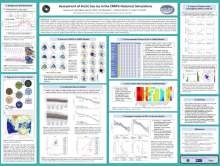An Assessment of the CMIP6 Historical Simulations of Arctic Sea Ice
Younjoo
Lee
Naval Postgraduate School
Poster
Evaluations of the Arctic sea ice response to a warming climate in Earth system model (ESM) simulations have been performed to assess the models’ capability to represent the past and project future regional climate change. The satellite-based total Arctic sea ice extent (SIE) has been commonly used as a metric in such analyses. However, this approach allows only a temporal assessment and does not account for potential spatial error cancelations. To address such limitations, we performed a comprehensive analysis of Arctic sea ice in the Coupled Model Intercomparison Project Phase 6 (CMIP6) historical simulations using more complex metrics. These include the integrated ice edge error (IIEE), Brier score (BS), and spatial probability score (SPS) and are referenced to satellite observations and results from the Pan-Arctic Ice Ocean Modeling and Assimilation System (PIOMAS) and the Regional Arctic System Model (RASM).
We found that, while the CMIP6 multi-model mean captures the mean annual cycle and the 1979–2014 sea ice trends, individual models demonstrate substantial variability in spatial distribution and sea ice decline rates. Notably, 40% of the CMIP6 models and 13% of the ensemble members depict the observed trends and acceleration in sea ice area (SIA) decline. However, simulations of sea ice volume (SIV) present a larger spread and uncertainty, suggesting a need for improved observational constraints. Our findings reveal pronounced regional biases and errors in the modeled seasonal ice edge and thickness, particularly in marginal and shelf seas, highlighting model limitations in capturing key physical processes potentially tied to oceanic forcing. The sea ice trend analysis indicates that models with higher northward ocean heat transport better simulate sea ice declines, implying an emergent constraint related to ice-ocean interactions and the necessity for improved modeling of critical polar processes, such as frazil ice growth. The presented assessment is recommended for future model evaluations to diagnose model biases and help identify potential processes to reduce these biases to improve the representation and projections of sea ice in ESMs, especially in terms of sea ice spatial distribution and accelerated trends in sea ice loss.
We found that, while the CMIP6 multi-model mean captures the mean annual cycle and the 1979–2014 sea ice trends, individual models demonstrate substantial variability in spatial distribution and sea ice decline rates. Notably, 40% of the CMIP6 models and 13% of the ensemble members depict the observed trends and acceleration in sea ice area (SIA) decline. However, simulations of sea ice volume (SIV) present a larger spread and uncertainty, suggesting a need for improved observational constraints. Our findings reveal pronounced regional biases and errors in the modeled seasonal ice edge and thickness, particularly in marginal and shelf seas, highlighting model limitations in capturing key physical processes potentially tied to oceanic forcing. The sea ice trend analysis indicates that models with higher northward ocean heat transport better simulate sea ice declines, implying an emergent constraint related to ice-ocean interactions and the necessity for improved modeling of critical polar processes, such as frazil ice growth. The presented assessment is recommended for future model evaluations to diagnose model biases and help identify potential processes to reduce these biases to improve the representation and projections of sea ice in ESMs, especially in terms of sea ice spatial distribution and accelerated trends in sea ice loss.

Poster file
lee-younjoo-confronting-poster.pdf
(5.07 MB)
